
Nippon Professional Baseball or NPB is the highest level of baseball in Japan. Locally, it is often called Puro Yakyū (プロ野球), meaning simply Professional Baseball; outside of Japan, NPB is often referred to as "Japanese baseball."

Rakuten Mobile Park Miyagi, officially Miyagi Baseball Stadium, is a baseball stadium in Miyaginohara Sports Park in Sendai, Miyagi Prefecture, Japan. The 30,508-seat park is owned by the prefecture and operated by Rakuten, which has used it as the home field for the Tohoku Rakuten Golden Eagles of Nippon Professional Baseball (NPB) since 2005. Its symmetrical playing surface is the only natural turf field in the Pacific League (PL). An amusement park, Smile Glico Park, is integrated into the stadium's left field seating and features a Ferris wheel.
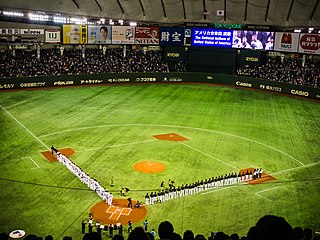
Baseball was introduced to Japan in 1872 and is Japan's most popular participatory and spectator sport. The first professional competitions emerged in the 1920s. The highest level of baseball in Japan is Nippon Professional Baseball (NPB), which consists of two leagues, the Central League and the Pacific League, with six teams in each league. High school baseball enjoys a particularly strong public profile and fan base, much like college football and college basketball in the United States; the Japanese High School Baseball Championship, which takes place each August, is nationally televised and includes regional champions from each of Japan's 47 prefectures.

Heiwadai Baseball Stadium was a ballpark located in the Fukuoka, Fukuoka Prefecture, Japan. From 1950 to 1978, it served as the home ballpark of the Nishitetsu Lions, a team in Nippon Professional Baseball's (NPB) Pacific League. It also briefly served as the home stadium for NPB teams the Nishi Nippon Pirates in 1950 and the Fukuoka Daiei Hawks from 1989 to 1992. The stadium hosted 1,904 official NPB games in its almost 58-year history.

Shota Takeda is a Japanese professional baseball pitcher for the Fukuoka SoftBank Hawks of Nippon Professional Baseball (NPB).
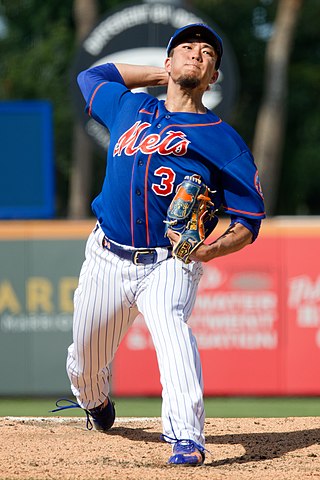
Kodai Senga is a Japanese professional baseball pitcher for the New York Mets of Major League Baseball (MLB). He made his Nippon Professional Baseball (NPB) debut in 2012 for the Fukuoka SoftBank Hawks, and played for them until 2022. He is a three-time NPB All-Star and a one-time MLB All-Star.

Nao Higashihama is a Japanese professional baseball pitcher for the Fukuoka SoftBank Hawks of Nippon Professional Baseball.
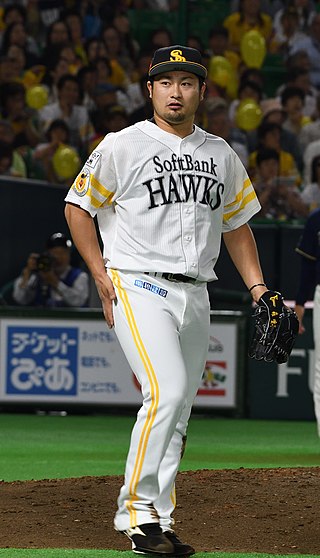
Yuito Mori is a professional Japanese baseball player. He plays pitcher for the Yokohama DeNA BayStars.

Jumpei Takahashi is a Japanese former professional baseball pitcher.

Interleague play, officially titled Nippon Life Interleague Play for event sponsor Nippon Life, is an event consisting of 108 regular-season baseball games played between Central League (CL) and Pacific League (PL) teams in Nippon Professional Baseball (NPB).
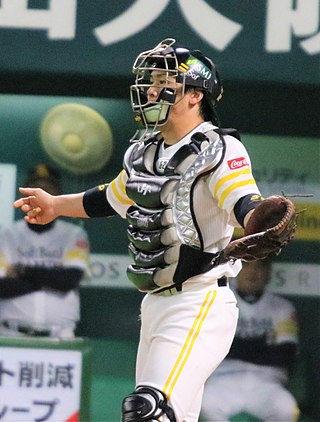
Takuya Kai is a Japanese professional baseball catcher for the Fukuoka SoftBank Hawks of the Nippon Professional Baseball (NPB).

Shinya Kayama is a Japanese professional baseball pitcher for the Tokyo Yakult Swallows.

Rei Takahashi is a Japanese professional baseball pitcher for the Yomiuri Giants of the Nippon Professional Baseball (NPB). He has previously played in NPB for the Fukuoka SoftBank Hawks.

Kotaro Otake is a Japanese Professional baseball pitcher for the Hanshin Tigers of Nippon Professional Baseball (NPB). He played for the Fukuoka SoftBank Hawks until the 2022 season.

Arata Shiino is a Japanese professional baseball pitcher.
The 2020 Nippon Professional Baseball season was the 71st season of professional baseball in Japan since Nippon Professional Baseball (NPB) was reorganized in 1950. There were 12 NPB teams, split evenly between the Central League and Pacific League.
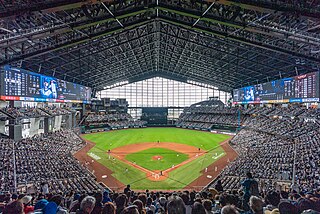
Es Con Field Hokkaido is a baseball stadium located in Kitahiroshima, Hokkaido, Japan. The ballpark is owned by and operated by Nippon Ham, which has used it as the home field for the Hokkaido Nippon-Ham Fighters of Nippon Professional Baseball (NPB) since its opening in 2023. Designed by Obayashi Corporation and HKS Architects, the stadium has capacity for 35,000 people. It is Japan's second retractable roof facility and its asymmetrical playing surface is only the third natural turf field in NPB. The area immediately surrounding the stadium is being developed into Hokkaido Ballpark F Village, an entertainment district that holds commercial facilities and restaurants.
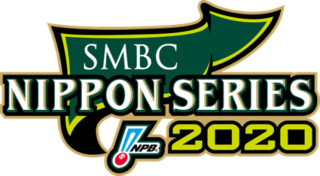
The 2020 Japan Series was the championship series of Nippon Professional Baseball's (NPB) 2020 season. The 71st edition of the Japan Series, it was played from November 21 to 25. The series was a best-of-seven playoff between the Fukuoka SoftBank Hawks, the Pacific League's (PL) Climax Series champion, and the defending Japan Series champions, and the Yomiuri Giants, the Central League's (CL) regular-season champion. The series was a rematch of the previous year's Japan Series.

Takashi Umino is a Japanese professional baseball catcher for the Fukuoka SoftBank Hawks of Nippon Professional Baseball.

The 2021 Japan Series was the championship series of Nippon Professional Baseball's 2021 season. The 72nd edition of the Japan Series, it was a best-of-seven playoff between the Orix Buffaloes and Tokyo Yakult Swallows, the winners of the Pacific and Central League's Climax Series, respectively. Both teams were the winners of their respective league's regular season championship.


















